MARKET OVERVIEW
The Global Fire Sprinkler Service Testing Market and industry remain concerned with the maintenance, reliability, and certification of fire sprinkler systems in the commercial, industrial, and residential fields. Fire protection is one of the most critical parts of building safety, and testing services are vital to determine that these systems work under emergency conditions. Demand for these services has steadily increased due to regulations creating ever-stricter compliance requirements, thus turning fire safety assessments into integral parts of property management and construction jobs.
Such testing is an array of tests that measure the workings of the fire sprinkler, including, but certainly not limited to, hydraulic flow testing, hydrostatic pressure testing, and obstruction investigation. Inspections are performed routinely to identify any mechanical failure, corrosion, or blockage hindering system efficiency. These services are not only obligatory, but they also act to identify and lessen any potential risk to property owners from catastrophic fire incidents.
The Global Fire Sprinkler Testing Service Market transcends various sectors such as hospitality, health, manufacture, education, and government. Each of these industries requires an individual testing approach depending on the building configuration, occupancy arrangement, and operational hazards. High-rise buildings and residential complexes equally account for market sustenance, since property management firms observe fire safety regulation compliance so as to safeguard residents and property.
Tightening fire safety rules continue to play a principal role in the growth of the fire sprinkler inspection sector. The degrees to which rules reflect fire inspector guidelines relative to management systems is regionally dynamic, and regulation generally comprises aspects from OSHA, NFPA, and/or local fire codes. With continued urban growth of populations taking place throughout the world, increased rigidity in regulation and enforcement in developing nations will also serving to spur the marketplace for testing service provision.
Technology integration is set to redefine the process of diagnosis of fire sprinkler testing services. The new generation of monitoring systems-linked to the idea of cloud-based predictive analytics and including solutions such as remote sensors that guarantee testing accuracy and testing efficiency-will monitor the health of sprinkler systems in real time, diminishing manual inspection measures to boost safety controls. They will further enhance the degree of automation in testing procedures, and compliance assessment will thus be easier for corporations to comply with fire safety requirements.
The Wildfire Sprinkler Testing Service providers vary from small companies that provide fire protection to big plant facilities management firms. Many of these service providers offer combined services involving installation, maintenance, and inspection, even for their most varied clientele. The competition among service providers will only increase if companies seek to provide fast yet reliable solution testing.
Regional factors impose significant influences upon the market dynamics. Developed economies already maintain an organized system in fire safety testing, with registered service providers ensuring compliance with industry standards. Emerging markets would, however, expect their testing infrastructure to develop through increased construction activity and awareness of fire safety regulations. Fire safety initiatives at the global level would bring many businesses and regulators to the focus of improving their testing standards.
The outlook of the Global Fire Sprinkler Testing Service Market overwhelmingly remains strong, given the regulatory growth, advances in technology, and rising safety consciousness. Fire protection will forever remain a top concern for businesses and property owners, while testing services will always make an important part of their safety management strategies. Continuous transformation of the industry will therefore be witnessed, as techniques of digital inspection and automated testing solutions render compliance more efficient and effective for stakeholders around the world.
Global Fire Sprinkler Testing Service market is estimated to reach $740.97 Million by 2032; growing at a CAGR of 3.6% from 2025 to 2032.
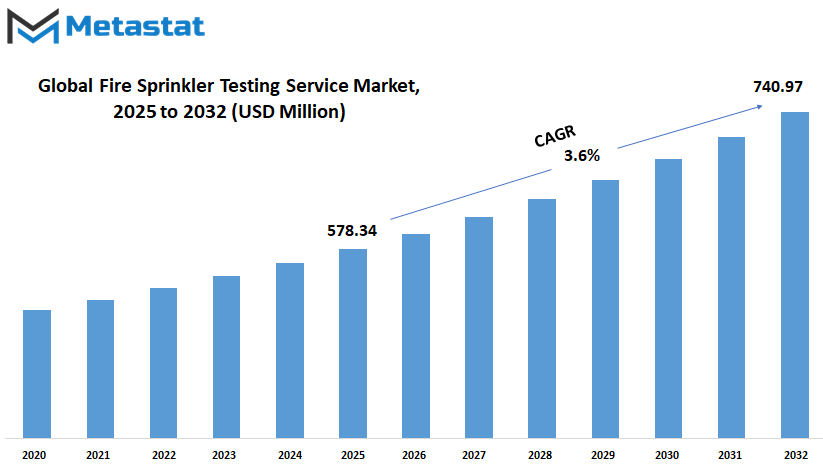
GROWTH FACTORS
In the coming years, the Global Fire Sprinkler Testing Service market is anticipated to grow substantially due to fire safety regulations gaining momentum and risk prevention awareness gaining ground. Governments and regulatory bodies have leashed an assortment of stringent requirements that include regular inspections and maintenance of fire sprinkler systems. With this, the demand for testing services has exploded for commercial buildings and residential structures alike to ensure compliance and mitigate potential fire risks. Fire safety will remain a focus area with continuing urban development and infrastructure growth, thus driving the need for efficient and reliable testing solutions.
Awareness of fire prevention measures has dramatically increased due to an influx of businesses and homeowners that have realized the importance of proactive risk management. Property owners are moving towards ensuring periodic inspections to mitigate potential damage and ensure occupant safety. On the other hand, insurance companies have been encouraging or even mandating regular testing since well-maintained fire sprinkler systems lower the risk of expensive claims. Moving forward, the pool away from reactive solutions and towards preventive measures will aid market growth.
Despite this increasing demand, a few impediments could temper the growth of the testing services sector. The costs for regular testing and maintenance can be quite high and many industries resist regular inspections. Additionally, the retrofitting of very old buildings with antiquated sprinkler systems poses serious problems wherein modern testing methods may be incorporated. In these scenarios, the retrofitting often involves extensive alterations that are usually costly and complex. However, these challenges will soon be easy to overcome as technology develops and other systematic solutions become available.
One of the most promising developments in this very sector is the use of IoT-based remote monitoring systems. Smart sensors in automated testing solutions continuously monitor the performance of fire sprinklers, detecting the onset of any issues before they reach critical proportions. This innovation will enhance efficiency, reduce the burden on manual inspections, and foster greater compliance in a cost-effective manner. These systems would continue to evolve alongside technology to offer utmost accuracy and reliability for fire protection.
On the market side, the Global Fire Sprinkler Testing Service industry, in the foreseeable future, will get strong supports from factors that simply comply with safety. Regulatory enforcement, public awareness, and technological innovation will dictate the path of this industry. Testing service companies need to adapt vastly to the changes in demand and invest smartly if they want to remain competitive. With an increasingly growing focus on safety and efficiency, the market will further evolve to ensure better protection of the buildings and the people within.
MARKET SEGMENTATION
By Type
The Global Fire Sprinkler Testing Service market has a good chance of expanding in the years to come. Stricter regulations on safety are generally being implemented around the world, thus increasing the demand for reliable fire protection systems. Fire sprinklers are very important in the protection of lives and property, thus requiring regular testing and maintenance.
The future may see more and more improvements in testing methodologies. Classical in situ visual inspection methodologies may be supplanted by more automated systems, yielding more exacting and precise determinations of condition. In so doing, some of these innovations will allow for the increased accuracy of testing, decreased time, and reduced resource utilization for such innovations.
The market is divided according to the type of sprinkler system in each of which different tests are needed. Wet Pipe Testing is used for sprinkler systems where the pipes are filled with water and ready for discharge upon heat detection. This type is commonly found in buildings where temperatures usually remain above freezing. Testing regularly makes sure that these systems promptly respond to fire incidents.
Dry Pipe Testing concerns systems where pressurized air or nitrogen is present within the pipe keeping water in a remote location until needed. Such systems are appropriate for freezing environments such as unheated warehouses. Testing of these systems makes certain that water would be available as soon as a fire is detected.
Pre-action Testing is considered for are those systems that require a two-step process for any water release. First, a detection system would recognize a potential fire, allowing water to enter the pipes. Water would be discharged only after the activation of a sprinkler head. This arrangement is the most helpful in places where the risk of water damage must be minimized: for example, data centers. Testing ensures that detection and sprinkler activation work in tandem.
Deluge System Testing is for systems that discharge a large volume of water in the shortest possible time. All sprinkler heads are open, and, with activation, water flows out simultaneously from all outlets. These systems are typically installed in areas where the risk is high, for example, chemical storage areas. Testing ensures that the system can deliver the water at the required volume in a timely manner.
Clearly, in the foreseeable future, the Global Fire Sprinkler Testing Service market will witness transformational influences due to the introduction and proliferation of smart technologies. Real-time monitoring enabled through IoT devices and sensors will further allow predictive maintenance and immediate response in case of particular issues arising with the system. This, consequently, would lead to increased safety and reduced probability of system failures.
By Component
The developmental phase of the Global Fire Sprinkler Testing Service market is set to continue, since fire safety is gaining due attention and importance worldwide. With the growth of urbanization as well as the increasing complexity of buildings needing reliable fire suppression systems, the demand will continue to heighten. Regular functioning checks on these systems are an absolute must, ensuring that the systems work in the emergency situation thereby sparing property loss and saving lives. Different forms of industries, such as commercial, residential, and industrial, will be reliant on these services to keep safety standards intact and meet regulations.
The various components of fire sprinkler systems must be tested to assure their effectiveness. Among the major components are the sprinkler heads, which will activate when there is a rise in temperature so as to control or extinguish a fire. Periodic testing ensures their activation without obstruction or defect. Alarm valves are integral to signal when a sprinkler system is activated, commanding the attention of the occupants and emergency services; without effective testing regimes, they could fail to do so, with a consequence of delayed response and increased fire risk.
Control valves direct the flow of water through a system into the areas that require it. Their proper working is essential to avoid malfunctions such as loss of water supply or undesired activations. In the same breath, flow switches are utilized to identify the changes in water movement within the pipes. They issue signals when the system works, thereby facilitating the fast identification of any leaks or blockages. Testing all the components of the fire sprinkler system must be undertaken periodically to keep the system's operational efficiency and trustworthiness.
In the future, we could look for more technological changes to add flavor to fire sprinkler testing services. Automation to control real-time evaluation without manual inspection may already be available or could be coming in very near future. Sensors and AI may also be integrated to predict failures arising far ahead of time for increased safety. Smart buildings with interlinked fire protection systems could connect and directly communicate with emergency responders, allowing for speedy responses and reduced damage.
The rules concerning fire safety might also change in such a way as to tighten the test requirements. Business owners and property owners will have to keep abreast with compliance standards so that the fire sprinkler systems installed at their premises meet the current codes. An increase in the awareness of fire hazards will in turn contribute to the increase in demand for professional testing services, which thus become an indispensable part of building maintenance and upkeep.
Having all these transformations, the Global Fire Sprinkler Testing Service market will continue to play an indispensable role in saving lives and properties. The safe standards would be maintained and stricter in the world by the maintenance and improvement of fire sprinkler systems.
By Service Type
In the upcoming years, the Global Fire Sprinkler Testing Service market is expected to grow immensely due to heightened safety awareness and increasing regulatory requisitions. With urban infrastructures on the rise due to urbanization, the demand for fire protection systems has become extremely crucial. For these systems to function in emergencies, regular testing and maintenance of these systems become imperative to truly save lives and property.
Within this market, a major industry categorization includes Inspection Services, Maintenance Services, and Certification Services. Inspection Services provide a meticulous inspection of all fire sprinkler systems to display all kinds of defects: corrosion, leaks, or blockages that would render the system incapable of performing its intended function. The aim is to identify problems, which promote timely intervention to repair or refurbish this equipment. Inspection becomes increasingly important with the aging of buildings and degradation that environmental conditions can inflict over time.
Maintenance Services deal with the continuous day-to-day upkeep needed to ensure fire sprinklers operate optimally. This works cleaning the sprinkler heads, testing water pressure, and checking all components for operability. Maintenance enhances the reliability of the fire system equipment, thereby increasing the chances of its survival. In a potential future where smart tech exists within building management, predictive maintenance, which uses data analytics and sensors to predict and solve issues before they escalate, is poised to be an industry standard.
Certification Services ascertain orderly proof for the fire sprinkler system that meets safety standards and regulations laid down. For commercial and residential properties, getting certification becomes a valid proof of being compliant with all the fire safety regulations. The certification services will be an important determining factor to ensure that systems are current and updated in keeping with regulations that evolve with new technology and address newer fire hazards.
Advanced technology such as IoT and AI will change the fire sprinkler testing service industry in the foreseeable future. Monitoring the system's performance using IoT-enabled devices will be done in real-time, while AI will analyze data for predicting potential failures and recommending pro-active actions. These developments will be of tremendous benefit in inspection, maintenance, and certification processes.
The harmful effects of using this technology on the environment are becoming an increasingly important subject of discussion, thereby increasing the emphasis on sustainable solutions for fire protection. Development of eco-friendly sprinklers and the green practices being followed in testing and maintenance become part of the sustainable approach. Organizations that offer their fire protection services on sustainability will have a competitive edge in this arena.
The Global Fire Sprinkler Testing Service market is poised for strong growth, with technological advancement, regulatory advancement, and an increasing focus on safety and sustainability underpinning this growth. Service providers that change their lenses to these trends, adaptable and innovative in their approach, aligned with the modern standard, will by then be in a prominent position to supply for the ever-increasing demand for reliable and efficient fire protection solutions.
By End-Users
As awareness about fire safety rises and regulations across different sectors become tighten, growth in the Global Fire Sprinkler Testing Service market is expected significantly in the next few years. Since urbanization requires reliable fire protection systems, especially in highly populated areas, this increase in urban development calls for regular testing and maintenance of fire sprinkler systems for their performance.
With an increasing emphasis on fire safety measures to protect human lives and valuable properties, regular testing services for the sprinkler systems must be carried out to minimize potential losses due to fire damage, so that businesses can recover soon after a fire disaster.
Fire sprinkler systems are experiencing increasing adoption in residential buildings. Recognizing that these systems afford early fire detection and suppression, critical in averting loss of lives and destruction of property, homeowners and housing authorities espouse their use. With increased integration of these systems in residential complexes, the demand for their professional testing services to prove their efficiency is becoming more pronounced.
Industrial facilities present a unique challenge in terms of fire hazards, owing to the actual presence of flammable materials and complex machinery in manufacturing plants and warehouses. In this regard, the absolute reliability of fire sprinkler systems is vital to avert catastrophic incidents. Regular testing services help to identify and rectify any faults, ensuring that the systems operate correctly during emergencies.
Institutional buildings, such as schools, hospitals, and offices of various government authorities, usually accommodate large populations and are expected to adhere to stringent fire safety requirements. Fire sprinkler systems need to operate seamlessly within these facilities to protect all occupants and maintain effective service delivery. Periodic testing and maintenance are key in attaining the fire safety standards required by the regulatory authorities.
Thus, the outlook of the market is conditioned by a mini-renaissance in technologically advanced equipment that will change the landscape of the Global Fire Sprinkler Testing Service Market. Smarter technologies, featuring an array of IoT-enabled sensors and automated monitoring systems, will promote efficiency and accuracy in testing procedures. Real-time monitoring and predictive maintenance will become available through these innovations, further diminishing the chances of any kind of system failure and elevating safety.
|
Forecast Period |
2025-2032 |
|
Market Size in 2025 |
$578.34 million |
|
Market Size by 2032 |
$740.97 Million |
|
Growth Rate from 2025 to 2032 |
3.6% |
|
Base Year |
2024 |
|
Regions Covered |
North America, Europe, Asia-Pacific, South America, Middle East & Africa |
REGIONAL ANALYSIS
As awareness about fire safety rises and regulations across different sectors become tighten, growth in the Global Fire Sprinkler Testing Service market is expected significantly in the next few years. Since urbanization requires reliable fire protection systems, especially in highly populated areas, this increase in urban development calls for regular testing and maintenance of fire sprinkler systems for their performance.
With an increasing emphasis on fire safety measures to protect human lives and valuable properties, regular testing services for the sprinkler systems must be carried out to minimize potential losses due to fire damage, so that businesses can recover soon after a fire disaster.
Fire sprinkler systems are experiencing increasing adoption in residential buildings. Recognizing that these systems afford early fire detection and suppression, critical in averting loss of lives and destruction of property, homeowners and housing authorities espouse their use. With increased integration of these systems in residential complexes, the demand for their professional testing services to prove their efficiency is becoming more pronounced.
Industrial facilities present a unique challenge in terms of fire hazards, owing to the actual presence of flammable materials and complex machinery in manufacturing plants and warehouses. In this regard, the absolute reliability of fire sprinkler systems is vital to avert catastrophic incidents. Regular testing services help to identify and rectify any faults, ensuring that the systems operate correctly during emergencies.
Institutional buildings, such as schools, hospitals, and offices of various government authorities, usually accommodate large populations and are expected to adhere to stringent fire safety requirements. Fire sprinkler systems need to operate seamlessly within these facilities to protect all occupants and maintain effective service delivery. Periodic testing and maintenance are key in attaining the fire safety standards required by the regulatory authorities.
Thus, the outlook of the market is conditioned by a mini-renaissance in technologically advanced equipment that will change the landscape of the Global Fire Sprinkler Testing Service Market. Smarter technologies, featuring an array of IoT-enabled sensors and automated monitoring systems, will promote efficiency and accuracy in testing procedures. Real-time monitoring and predictive maintenance will become available through these innovations, further diminishing the chances of any kind of system failure and elevating safety.
In conclusion, the Global Fire Sprinkler Testing Service market is thriving because all end users are putting their energies into the promotion of fire safety. The further down the road we look, the more regular and advanced testing services will matter in saving lives and property across the earth.
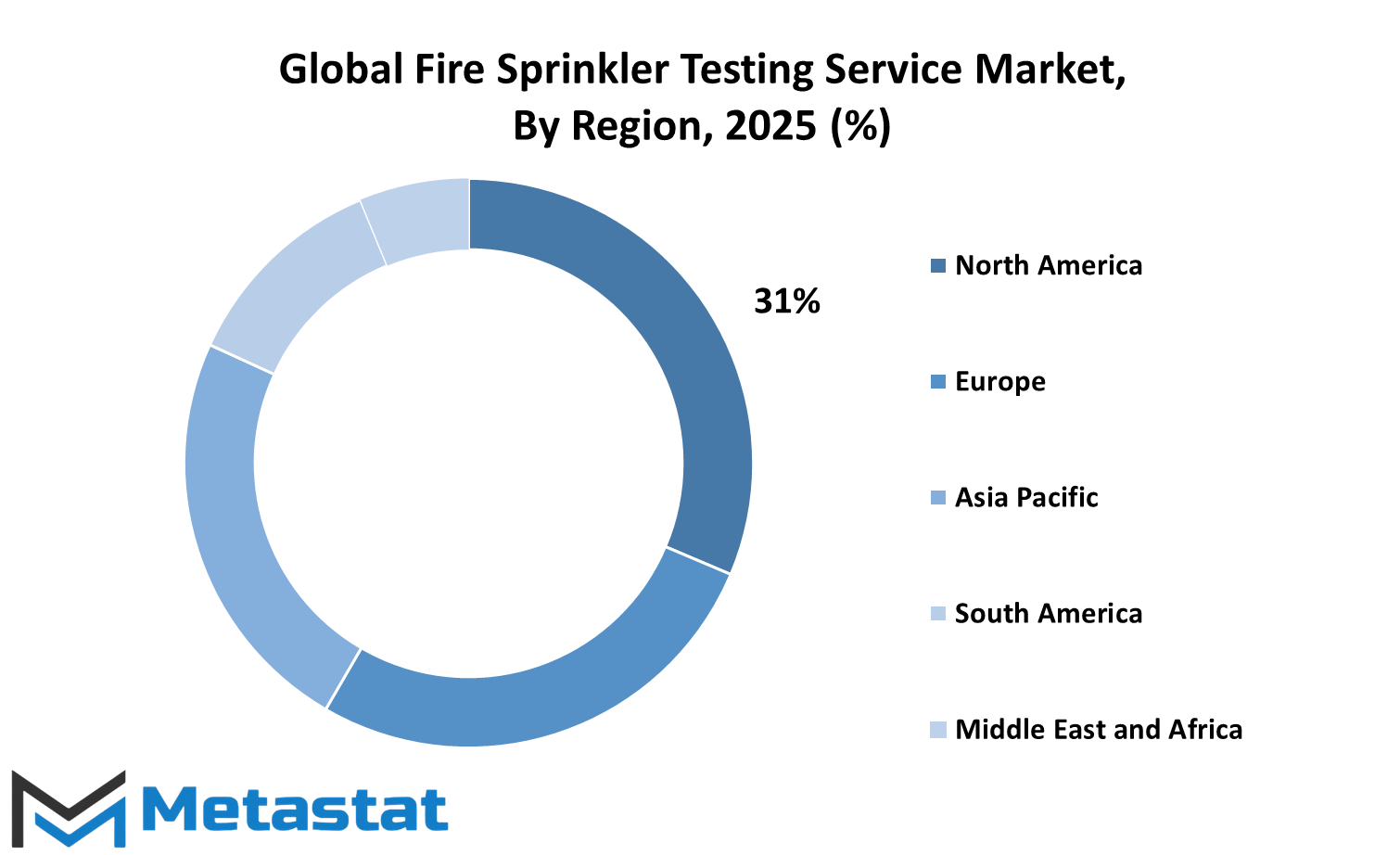
COMPETITIVE PLAYERS
The market for Global Fire Sprinkler Testing Services would get stimulated along with the increase in fire prevention systems needs and stricter safety regulations. Fire sprinklers indeed play an important role in restricting fire spread as well as saving lives and property. With urbanization expansion and the evolution of commercial and industrial infrastructures, there will always be an increase in the demand for consistent and high-quality testing services. The performance of these systems is usually a legal requirement in many jurisdictions as well as part of critical risk management, not just for businesses but also for residential buildings.
As technology grows, so do the automated fire protection systems, which become more advanced. Expectedly, some of the smart fire sprinklers, having sensors and monitoring capabilities, would join the mainstream of many industries. Testing these innovations would have to be regular as well as specific for the appraised performance. Thus, fire sprinkler testing companies would have to include these developments in their framework in terms of digital tools and predictive maintenance. This change would not only ensure safety measures but also enhance the efficiency of fire suppression systems.
The Global Fire Sprinkler Testing Service market is likely to sustain competition as major companies are likely to expand services and develop new methodologies of testing. Key Players in this area include APi Group Inc., Applus+, and Cintas Corporation, who are partaking in advanced testing techniques to sustain their customers' ever-increasing need for credible fire protection. DEKRA SE and Intertek Group plc are also joining in the progressive expansion of the industry through their expertise in compliance and safety testing. Other important players in the industries of smart building technologies, such as Johnson Controls or Siemens AG, are likely to incorporate their innovations into testing services.
There are many other smaller companies, such as Harroun Fire Protection, J.F. Ahern Co., Pye-Barker Fire & Safety, LLC, and Western States Fire Protection Company, which are broadening their services to cover specific industries. Similarly, UL LLC, a major player in safety certification, serves an important function in the global trend of setting fire protection systems. As the competition intensifies, it can be anticipated that those having a stronghold in the industry will incline to quality testing at lower costs while investing in technology.
Under the increasing charge of fire safety regulations worldwide, the Global Fire Sprinkler Testing Service market would also transform. Those companies that embrace technological improvements as well as those that adjust their norms to the changing legal landscape would be best positioned to serve the growing demand for high-quality testing services. That operation would, for years ahead, make this market critical for public and private sectors alike: ensuring that fire sprinklers work effectively.
Fire Sprinkler Testing Service Market Key Segments:
By Type
- Wet Pipe Testing
- Dry Pipe Testing
- Pre-action Testing
- Deluge System Testing
By Component
- Sprinkler Heads
- Alarm Valves
- Control Valves
- Flow Switches
By Service Type
- Inspection Services
- Maintenance Services
- Certification Services
By End-Users
- Commercial Buildings
- Residential Buildings
- Industrial Facilities
- Institutional Buildings
Key Global Fire Sprinkler Testing Service Industry Players
- APi Group Inc.
- Applus+
- Cintas Corporation
- DEKRA SE
- Harroun Fire Protection
- Intertek Group plc
- J.F. Ahern Co.
- Johnson Controls
- Pye-Barker Fire & Safety, LLC
- Siemens AG
- UL LLC
- Western States Fire Protection Company
WHAT REPORT PROVIDES
- Full in-depth analysis of the parent Industry
- Important changes in market and its dynamics
- Segmentation details of the market
- Former, on-going, and projected market analysis in terms of volume and value
- Assessment of niche industry developments
- Market share analysis
- Key strategies of major players
- Emerging segments and regional growth potential



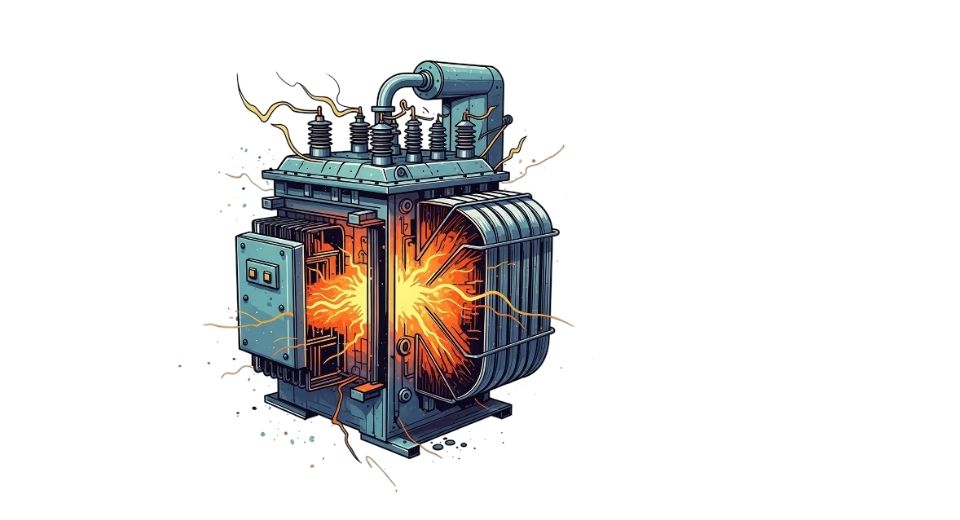
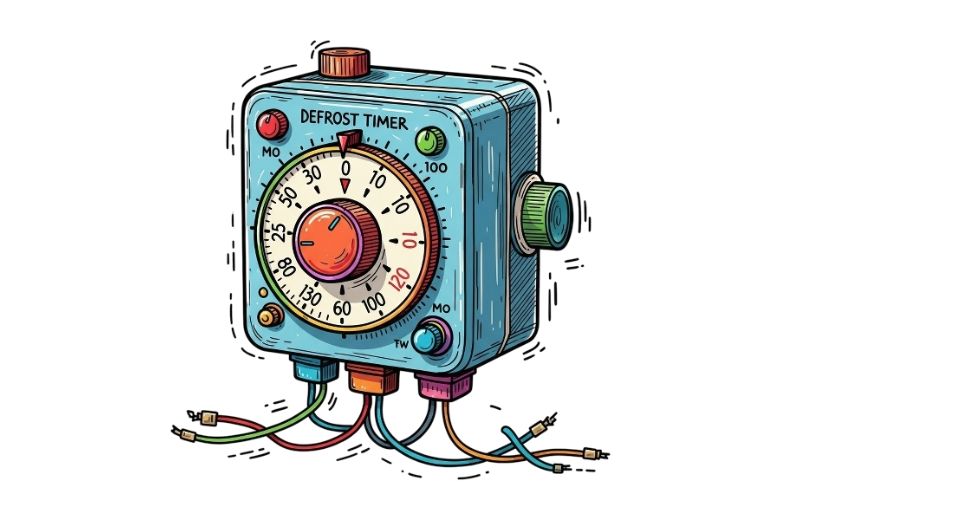
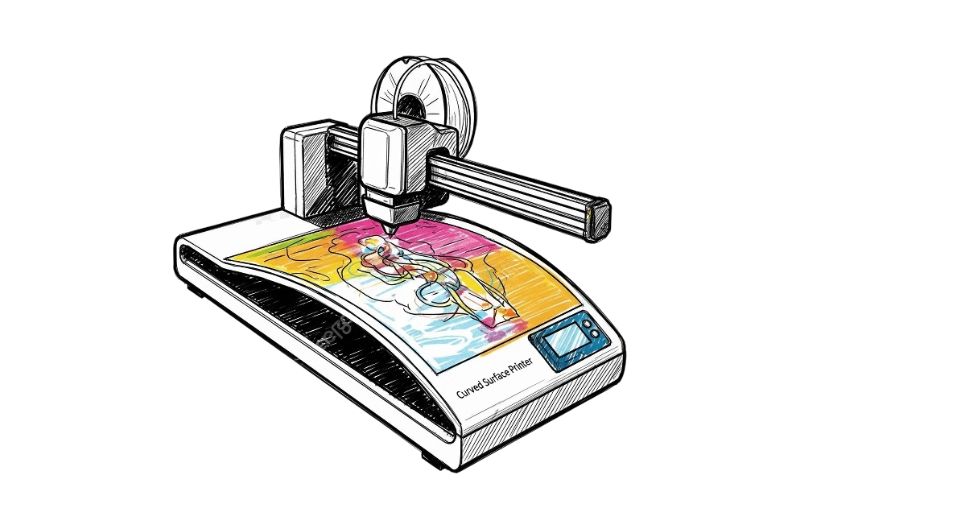
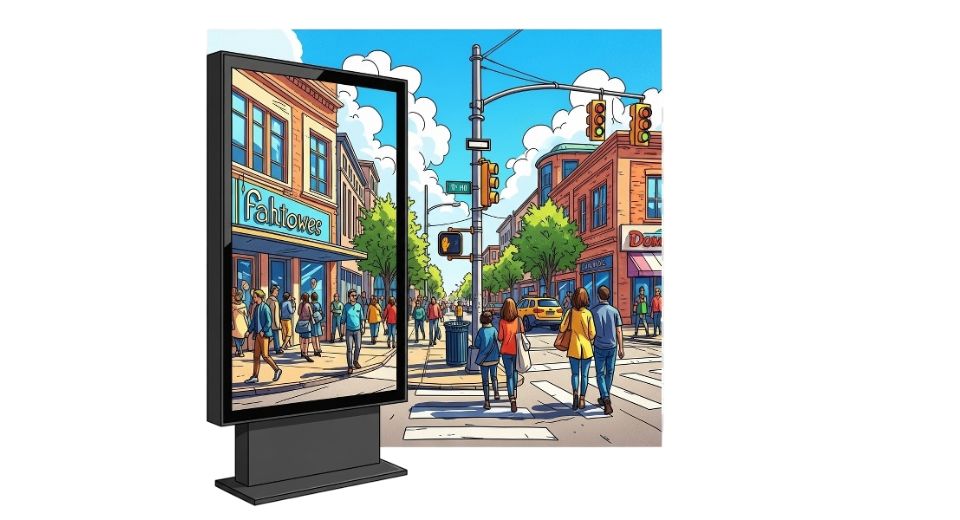

 US: +1 3023308252
US: +1 3023308252






